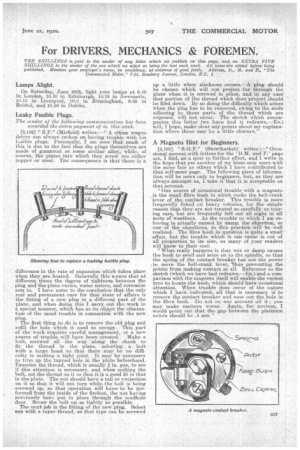For DRIVERS, MECHANICS & FOREMEN.
Page 35

If you've noticed an error in this article please click here to report it so we can fix it.
Lamps Alight.
On Saturday, June 26th, light your lamps at 9.49 in London, 10.30 in Edinburgh, 10.18 in Isewcastle, • 10.13 in Liverpool, 10.3 in. Birmingham, 9.59 in Bristol, and 10.56 in Dublin.
Leaky Fusible Plugs.
The sender of the following communication has been awarded .the extra payment of Sc. this week.
[42,102] " S.P." (Mir-field) writes :--" A stbam wagon driver can always .reckon on having trouble with his fusible plugs. Personal1y I am sure that much of thin is due to the fact that the plugs themselves are made of gunmetal or some similar alloy, while, of course, the plates • into which they screw are either copper or steel. The consequence is that there is a
difference in the rate of expansion which takes place when they are heated. Generally this means that at different times the degree of tightness between the plug and the plate varies, water enters, and corrosion sets in. I have come to the conclusion that the only real and permanent cure for that state of affairs is the fitting of a new plug in a different part of the plate, and when doing this I -tarry out the work in a special manner; which has as its object the elimination of the usual trouble in connection with the new plug.
• The first thing to do is to remove the old plug and refill the hale which it used to occup,y. This part of the work requires careful_ management; or a new Source of trouble will have been created. Make a bolt, screwed all the way along the shank to fit the thread in the plate, selecting a bolt with a large head so that there may be no difficulty in making a tight joint. It may be necessary to trim up the tapped hole in the plate beforehand. Examine the thread, which is usually in. gas, to see if this attention is necessary, and when making the bolt, cut the thread on it so that it is a good fit in that in the plate. The nut should have a, tail or projection on it so that it will not turn while the bolt is being screwed up, an that operation will have-to be performed from the inside of the firebox, the nut having previously been put in place through the mudhole door. Screw the bolt up. as tightly as possible. The next job is the fitting of the new plug. Select one with a taper thread, as that type can be screwed
up a -little when slackness nceurs A plug. should be chosen which will not projectfar through the plate • when it is soreWed -in place, and in apy case that portion of the thread which does project should be filed down. By so doing the difficulty which arises when the plug has to be removed, owing to the scale • adhering to those parts of the thread which are exposed, will not occur. The sketch which accompanies this letter (we have had it redrawn.—ED.). will, I hope, make clear any points about my explanation where these may be a little obscure."
A Magneto Hint for Beginners.
[2,103] "S.G.F." (Stow-market) writes :-=." Oceas sional success with letters for the D.M. and F.' page act, I find, as a spur to further effort, and I write in the hope that yet. another of my hints may meet with the same fate as others which I have eo-ntributed to that .self-same page. The following piece of information will be news only to beginners, but, as they are always amongst us, I take it that it is acceptable on that account.
"One source of occasional trouble with a magneto is the small fibre hush in which rooks the bell-crank lever of the contact. breaker. This trouble is more frequently fotind en heavy vehicles, for the simple reason that they are not treated so carefully as touring cars, but are frequently left out all night in all Sorts of weathers. As the trouble to which I am referi-ing is actually cause.d by damp, the objection, or one of the Gbje,ctions, to this practice will be well realized. The fibre hush in question is quite a small. affair, but the trouble which it can cause is out of all proportion to its size, as many of your readers will know to their cost.
"What really happens is that wet or damp causes the hush to swell and seize on to the spindle, so that the spring of the contact breaker has not the power , to move the bell-crank lever, thus preventing the points from malting contact at all. Reference to the sketch (which we have had redrawn.—En.) and a comparison with the magneto itself will enable the veriest tyro to locate the bush, which should have occasional attention. When trouble does occur of the nature which I have indicated, all that is necessary id to remove the contact breaker and ease out the hole in the fibre bush. Do not on any account. oil it ; you may make matters worse. Again, for novices, I
oubl point out that the gap between the platinum iints should be. .5 mm "




































